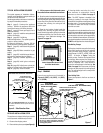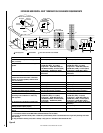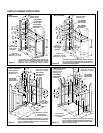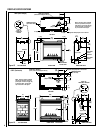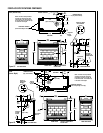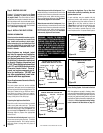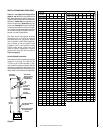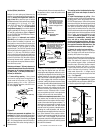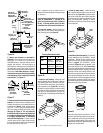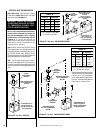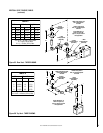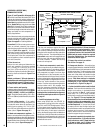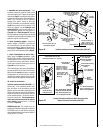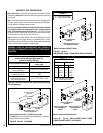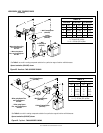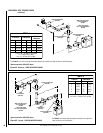
13
NOTE: DIAGRAMS & ILLUSTRATIONS NOT TO SCALE.
Framing Dimensions for Roof
Pitch C D
0/12 10¹⁄₂ in. 10¹⁄₂ in.
(267 mm) (267 mm)
6/12 10¹⁄₂ in. 12 in.
(267 mm) (305 mm)
12/12 10¹⁄₂ in. 17 ³⁄₄ in.
(267 mm) (451 mm)
C
D
Storm
Collar
8 feet (2.4 m)
Maximum
SV4.5CGV-1
Termination
SV4.5FA OR
SV4.5FB Flashing
AND SV4.5SC
STORM COLLAR
**SV4.5VF
Firestop/Spacer
1" (25.4 mm)
Minimum Clearance
to Combustibles
*SV4.5SU
Support Strap
SV4.5SP
*Support Plate
*Secured to Vent
With Appropriate
Fasteners
Ceiling
Framing
**When using Secure Flex,
use Firestop/Spacer
SF4.5VF
SV4.5E90
(90° Elbow)
7 ⁵⁄₈"
(194 mm)
Swivel Joint
(360
°
swivel)
4 ¹³⁄₁₆"
(122 mm)
SV4.5E45
(45° Elbow)
Swivel Joint
(360
°
swivel)
Figure 28
Figure 29
Figure 31
Figure 30
If the vent system extends more than 5' (1.5 m)
above the roof flashing, stabilizers may be nec-
essary. Additional screws may be used at sec-
tion joints for added stability. Guide wires may
be attached to the joint for additional support on
multiple joint configurations.
G. Continue installation of horizontal/inclined
sections - Continue with the installation of the
straight vent sections in horizontal/inclined run
as described in Step C. Install support straps
every 5 ft. (1.52 m) along horizontal/inclined
vent runs using conventional plumber’s tape.
See page 16, Figure 37.
It is very important
that the horizontal/inclined run be maintained
in a straight (no dips) and recommended to be
in a slightly elevated plane, in a direction
away from the fireplace of ¹⁄₄" rise per foot (20
mm per meter) which is ideal, though rise per
foot run ratios that are smaller are acceptable all
the way down to at or near level.
Figure 27
F. Change vent direction to horizontal/in-
clined run - At transition from or to a horizon-
tal/inclined run, install the SV4.5E45 and
SV4.5E90 elbows in the same manner as the
straight vent sections. The elbows feature a
twist section to allow them to be routed about
the center axis of their initial collar section to
align with the required direction of the next vent
run element. Twist elbow sections in a clock-
wise direction only so as to avoid the possiblity
of unlocking any of the previously connected
vent sections. See
Figure 27
.
Use a carpenter’s level to measure from a
constant surface and adjust the support straps
as necessary.
It is important to maintain the required clear-
ances to combustibles: 1" (25 mm) at all
sides for all vertical runs; and 3" (76 mm) at
the top, 1" (25 mm) at sides, and 1" (25 mm)
at the bottom for all horizontal/inclined runs.
K. Install the vertical termination - The final step
involves installation of the SV4.5CGV-1 Vertical
Termination. Extend the vent sections to the
height as shown in the "Vertical vent termination
section" on page 4. The SV4.5CGV-1 Vertical
Termination
(Figure 31)
can be installed in the
exact same fashion as any other Secure Vent
section. Align the termination over the end of the
previously installed section, adjusting the radial
alignment until the four locking dimples of the
termination are aligned with the inlets of the four
incline channels of the last vent section. Push the
termination down until it fully engages, then twist
the termination clockwise running the dimples
down and along the incline channels until they are
seated at the end of the channels.
I. Install the roof flashing - Extend the vent
sections through the roof structure. Install the
roof flashing over the vent section and posi-
tion such that the vent column rises vertically
(use carpenters level) (
Figure 29
). Nail along
perimeter to secure flashing or adjust roofing
to overlap the flashing edges at top and sides
only and trim where necessary. Seal the top
and both sides of the flashing with waterproof
caulking.
H. Frame roof opening - Identify location for
vent at the roof. Cut and/or frame opening per
Roof Framing Chart and
Figure 28
.
J. Install the storm collar - Install the storm
collar, supplied with the flashing, over the vent/
flashing joint. See
Figure 30.
Loosen the storm
collar screw. Slide collar down until it meets the
top of the flashing. Tighten the adjusting screw.
Apply non-combustible caulking or mastic
around the circumference of the joint to provide
a water tight seal.
Figure 26



